Resources
Instagram tiles
These Instagram tiles are designed for Predator Free 2050 organisations to use on their social media platforms to share the predator free story.
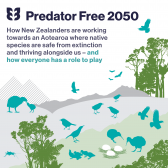 |
Introduction to Predator Free 2050 (png 645KB) Predator Free 2050 - How New Zealanders are working towards an Aotearoa where native species are safe from extinction and thrive alongside us – and everyone has a role to play. |
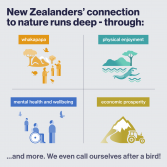 |
New Zealander's connection to nature runs deep (png 227KB) Through whakapapa, physical enjoyment, mental health and wellbeing, economic prosperity, and more. We even call ourselves after a bird! |
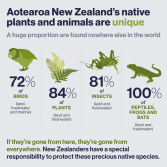 |
Aotearoa New Zealand’s native plants and animals are unique (png 356KB) A huge proportion are found nowhere else in the world: 72% of birds 84% of plants 81% of insects 100% of reptiles, frogs and bats If they’re gone from here, they’re gone from everywhere. New Zealanders have a special responsibility to protect these precious native species. |
 |
Introduced predators threaten nature (png 161KB) Introduced predators threaten nature. They kill an estimated 25 million native birds per year. |
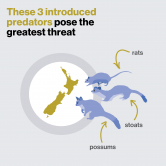 |
Introduced predators threaten nature (png 212KB) Three introduced predators pose the greatest threat - rats (ship rats, Norway rats, kiore), stoats (ferrets, weasels), and possums. |
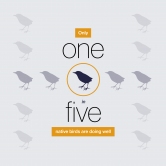 |
Introduced predators threaten nature (png 173KB) Only 1 in 5 native birds in Aotearoa New Zealand are doing well. |
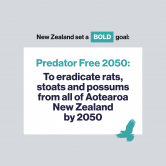 |
Predator Free 2050 goal (png 132KB) New Zealand set a bold goal: Predator Free 2050: To eradicate these three damaging predators from all of Aotearoa New Zealand by 2050. |
 |
Why we need to eradicate introduced predators (png 75KB) |
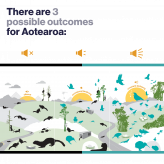 |
Why we need to eradicate introduced predators (png 545KB) There are three possible outcomes for Aotearoa. |
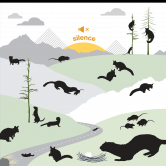 |
Why we need to eradicate introduced predators (png 322KB) |
 |
Why we need to eradicate introduced predators (png 153KB) No predator management - when we don't act for nature, introduced predators continue to eat precious native plants and animals. Many native animals would go extinct without action, some in as few as two human generations. New Zealander's connection to nature, wellbeing, recreation, economy, and tourism all suffer. |
 |
Why we need to eradicate introduced predators (png 398KB) |
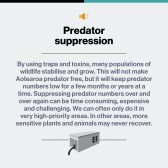 |
Why we need to eradicate introduced predators (png 194KB) Predator suppression - By using traps and toxins, many populations of wildlife stabilise and grow. This will not make Aotearoa predator free, but it will keep predator numbers low for a few months or years at a time. Suppressing predator numbers over and over again can be time consuming, expensive, and challenging. We often only do it in very high priority areas. In other areas, more sensitive plants and animals may never recover. |
 |
Why we need to eradicate introduced predators (png 447KB) |
 |
Why we need to eradicate predators (png 94KB) Predator eradication - With innovative tools and technologies, predators are completely removed and cannot re-enter. New Zealand's native plants and animals are safe from extinction and thriving. New Zealanders enjoy a deepened connection to nature, flourishing wildlife, recreation, international standing, and a bolstered economy. |
 |
Working together to achieve the goal (png 83KB) Any single organisation won’t achieve this ambitious goal alone – collaboration is key. The predator free movement brings together organisations and people from all walks of life. |
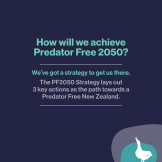 |
How will we achieve Predator Free 2050 (png 129KB) We've got a strategy to get us there. The PF2050 Strategy lays out three key actions as the path towards a Predator Free New Zealand. |
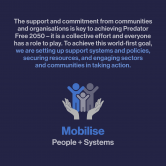 |
How will we achieve Predator Free 2050 (png 86KB) Mobilise - The support and commitment from communities and organisations is key to achieving Predator Free 2050 – it is a collective effort and everyone has a role to play. To achieve this world-first goal, we are setting up support systems and policies, securing resources, and engaging sectors and communities in taking action. |
 |
How will we achieve Predator Free 2050 (png 182KB) Innovate - If you’ve ever thought that Predator Free 2050 is impossible with the tools we’re using now, you’re right. We need new tools to achieve a Predator Free New Zealand by 2050. That’s why we’re investing in innovating new and transformational tools and techniques that we’ll need to eradicate predators. |
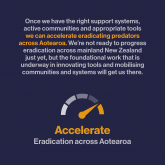 |
How will we achieve Predator Free 2050 (png 196KB) Accelerate - Once we have the right support systems, active communities and appropriate tools we can accelerate eradicating predators across Aotearoa. We’re not ready to progress eradication across mainland New Zealand just yet, but the foundational work that is underway in innovating tools and mobilising communities and systems will get us there. |
 |
How will we achieve Predator Free 2050 (png 233KB) We’re early in the goal and focusing on innovation and mobilising people and systems. |
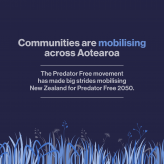 |
Communities are mobilising across Aotearoa (png 334KB) Communities are mobilising across Aotearoa. The Predator Free movement has made big strides mobilising New Zealand for Predator Free 2050. |
 |
Communities are mobilising across Aotearoa (png 351KB) In a short time, we've seen an explosion of more than 5,400 Trap.nz groups controlling predators by trapping. |
 |
Communities are mobilising across Aotearoa (png 333KB) Individuals all across Aotearoa are taking action - planting natives, donating, backyard trapping, volunteering. |
 |
Growing the toolbox for eradicating predators (png 136KB) Predator Free 2050 is one of Aotearoa New Zealand’s largest investments in research and development for nature. |
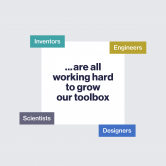 |
Growing the toolbox for eradicating predators (png 84KB) Inventors, engineers, scientists, and designers are all working hard to grow our toolbox. |
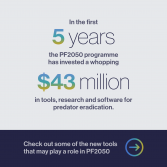 |
Growing the toolbox for eradicating predators (png 167KB) In the first 5 years the programme has invested a whopping $43 million in tools, research, and software for predator eradication. |
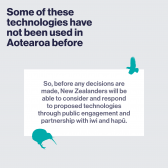 |
Growing the toolbox for eradicating predators (png 82KB) Some of these technologies have not been used in Aotearoa before So, before any decisions are made, New Zealanders will be able to consider and respond to proposed technologies through public engagement and partnership with iwi and hapū. |
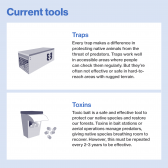 |
Growing the toolbox for eradicating predators (png 224KB) Current tools Traps - Every trap makes a difference in protecting native animals from the threat of predators. Traps work well in accessible areas where people can check them regularly. But they’re often not effective or safe in hard-toreach areas with rugged terrain. Toxins - Toxic bait is a safe and effective tool to protect our native species and restore our forests. Toxins in bait stations or aerial operations manage predators, giving native species breathing room to recover. However, this must be repeated every 2-3 years to be effective. |
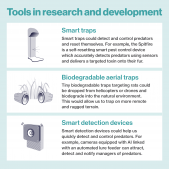 |
Growing the toolbox for eradicating predators (png 302KB) Tools in research and development Smart traps - Smart traps could detect and control predators and reset themselves. For example, the Spitfire is a self-resetting smart pest control device which accurately detects predators using cameras with AI and delivers a targeted toxin onto their fur. Biodegradable aerial traps - Tiny, biodegradable traps targeting rats could be dropped from helicopters or drones and biodegrade into the natural environment. This would allow us to trap on more remote and rugged terrain. Smart detection devices - Smart detection devices could help us quickly detect predators. For example, cameras equipped with AI linked with an automated lure feeder can attract, detect, and notify managers of predators. |
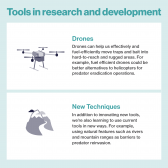 |
Growing the toolbox for eradicating predators (png 190KB) Tools in research and development Drones- Drones can help us effectively and fuel-efficiently move traps and bait into hard-to-reach and rugged areas. For example, fuel efficient drones could be better alternatives to helicopters for predator eradication operations. New Techniques - In addition to innovating new tools, we’re also learning to use current tools in new ways. For example, using natural features such as rivers and mountain ranges as barriers to predator reinvasion. |
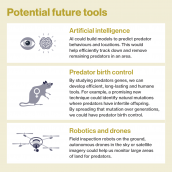 |
Growing the toolbox for eradicating predators (png 268KB) Potential future tools Artificial intelligence - AI could build models to predict predator behaviours and locations. This would help efficiently track down and remove remaining predators in an area. Predator birth control - By studying predators genes, we can develop efficient, long-lasting, and humane tools. For example, a promising new technique could identify natural mutations where predators have infertile offspring. By spreading that mutation over generations, we could have predator birth control. Artificial intelligence - AI could build models to predict predator behaviours and locations. This would help efficiently track down and remove remaining predators in an area. Robotics and drones - Field inspection robots on the ground, autonomous drones in the sky, or satellite imagery could help us monitor large areas of land for predators. |
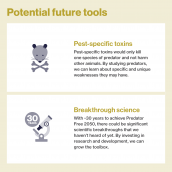 |
Growing the toolbox for eradicating predators (195KB) Potential future tools Pest-specific toxins: Pest-specific toxins would only kill one species of predator and not harm other animals. By studying predators, we can learn about specific and unique weaknesses they may have. Breakthrough science: With ~30 years to achieve Predator Free 2050, there could be significant scientific breakthroughs that we haven't heard of yet. By investing in research and development, we can grow the toolbox. |
 |
Acceleration on islands (png 184KB) With active communities and new tools, we will accelerate eradication across Aotearoa New Zealand. New Zealand is already a world leader in predator eradication. We achieved our first predator-free island in 1960. |
 |
Acceleration on islands (png 56KB) Over the last 70 years, we've built on that success by exponentially scaling up eradication to bigger and bigger islands. |
 |
Acceleration on islands (png 23KB) Kapiti Island |
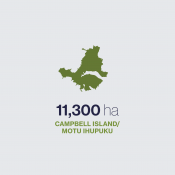 |
Acceleration on islands (png 86KB) Campbell Island |
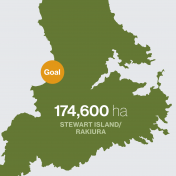 |
Acceleration on islands (png 165KB) Goal: Rakiura |
 |
Acceleration on islands (png 78KB) Aotearoa New Zealand has now eradicated predators on about 140 islands, and we'll use what we've learnt on these islands over decades to achieve eradication on the mainland New Zealand |
 |
Making progress towards Predator Free 2050 (png 61KB) In just a few years, we've made progress towards a predator free Aotearoa New Zaland. The Predator Free movement has already had the following achievements. |
 |
Making progress towards Predator Free 2050 (png 378KB) 5,400+ trapping projects across the country sharing their progress on trap.nz |
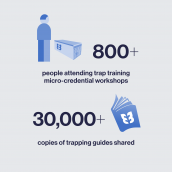 |
Making progress towards Predator Free 2050 (png 110KB) 800+ people attending trap training micro-credential workshops. 30,000+ copies of trapping guides shared. |
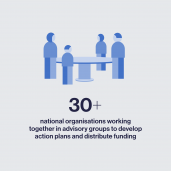 |
Making progress towards Predator Free 2050 (png 79KB) 30+ national organisations working together in advisory groups to develop action plans and distribute funding. |
 |
Making progress towards Predator Free 2050 (png 116KB) A collective strategy to get us to a Predator Free 2050 with input from people via facilitated workshops, surveys, digital engagement and hui. |
 |
Making progress towards Predator Free 2050 (png 86KB) Successful eradications on ~140 islands in New Zealand. |
 |
Making progress towards Predator Free 2050 (png 136KB) Successful urban eradications of possums, rats and mustelids on Te Motu Kairangi/Miramar Peninsula in Wellington. |
 |
Making progress towards Predator Free 2050 (png 109KB) Newly produced innovative tools and technologies like cameras with artificial intelligence and new self-resetting traps. |
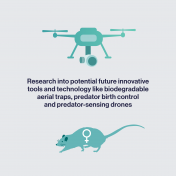 |
Making progress towards Predator Free 2050 (png 95KB) Research into potential future innovative tools and technology like biodegradable aerial traps, predator birth control and predator-sensing drones. |
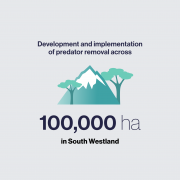 |
Making progress towards Predator Free 2050 (png 91KB) Development and implementation of predator removal across 100,000 ha in South Westland. |
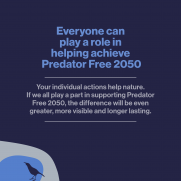 |
Everyone can play a role in Predator Free 2050 (png 69KB) Everyone can play a role in achieving Predator Free 2050. Your individual actions help nature. If we all play a part in supporting Predator Free 2050, the difference will be even greater, more visible and long lasting. |
 |
Everyone can play a role in Predator Free 2050 (png 119KB) Spread the word. You can also help by sharing the Predator Free story with your friends, family and online communities. |
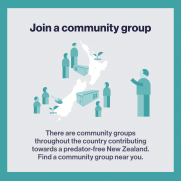 |
Everyone can play a role in Predator Free 2050 (png 151KB) Join a community group. There are community groups throughout the country contributing towards a predator-free New Zealand. Find a community group near you. |
 |
Everyone can play a role in Predator Free 2050 (png 187KB) Trap predators in your own backyard. You can make a difference by setting traps in your garden and catching predators like rats, possums and stoats. |
 |
Everyone can play a role in Predator Free 2050 (png 165KB) Make your garden welcoming for native wildlife. Planting native plants and providing habitat can make your garden a welcoming space for precious native animals. |
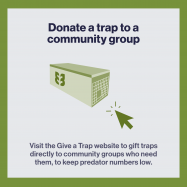 |
Everyone can play a role in Predator Free 2050 (png 116KB) Donate a trap to a community group. Visit the Give a Trap website to gift traps directly to community groups who need them, to keep predator numbers low.
|